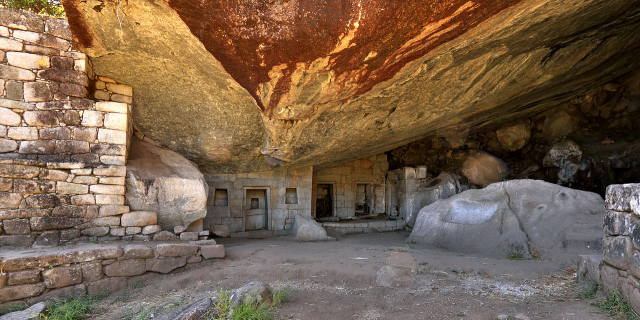Choquequirao (possibly from Quechua chuqi metal, k'iraw crib, cot) is an Incan site in southern Peru, similar in structure and architecture to Machu Picchu. The ruins are buildings and terraces at levels above and below Sunch'u Pata, the truncated hill top. The hilltop was anciently leveled and ringed with stones to create a 30 by 50 m platform.
Choquequirao at an elevation of 3,050 metres (10,010 ft) is in the spurs of the Vilcabamba mountain range in the Santa Teresa district, La Convención Province of the Cusco Region. The complex is 1,800 hectares, of which 30–40% is excavated. The site overlooks the Apurimac River canyon that has an elevation of 1,450 metres (4,760 ft).
The site is reached by a two-day hike from outside Cusco. Choquequirao has topped in the prestigious Lonely Planet's Best in Travel 2017 Top Regions list.
Choquequirao is a 15th- and 16th-century settlement associated with the Inca Empire, or more correctly Tahuantinsuyo.[1] The site had two major growth stages. This could be explained if Pachacuti founded Choquequirao and his son, Tupac Inca Yupanqui, remodeled and extended it after becoming the Sapa Inca.[2] Choquequirao is located in the area considered to be Pachacuti’s estate; which includes the areas around the rivers Amaybamba, Urubamba, Vilcabamba, Victos, and Apurímac.
Other sites in this area are Sayhuite, Machu Picchu, Chachabamba (Chachapampa), Choquesuysuy (Chuqisuyuy), and Guamanmarca (Wamanmarka); all of which share similar architectural styles with Choquequirao.[3] The architectural style of several important features appears to be of Chachapoya design, suggesting that Chachapoya workers were probably involved in the construction. This suggests that Tupaq Inka probably ordered the construction. Colonial documents also suggest that Tupac Inca ruled Choquequirao since his great grandson, Tupa Sayri, claimed ownership of the site and neighboring lands during Spanish colonization.[4]
It was one of the last bastions of resistance and refuge of the Son of the Sun (the "Inca"), Manco Inca Yupanqui, who fled Cusco after his siege of the city failed in 1535.
According to the Peruvian Tourism Office, "Choquequirao was probably one of the entrance check points to the Vilcabamba, and also an administrative hub serving political, social, and economic functions. Its urban design has followed the symbolic patterns of the imperial capital, with ritual places dedicated to Inti (the Incan sun god) and the ancestors, to the earth, water, and other divinities, with mansions for administrators and houses for artisans, warehouses, large dormitories or kallankas, and farming terraces belonging to the Inca or the local people. Spreading over 700 meters, the ceremonial area drops as much as 65 meters from the elevated areas to the main square."[5] The city also played an important role as a link between the Amazon Jungle and the city of Cusco.
DiscoveryAccording to Ethan Todras-Whitehill of the New York Times, Choquequirao's first non-Incan visitor was the explorer Juan Arias Díaz in 1710.[6] The first written site reference in 1768 was made by Cosme Bueno, but was ignored at the time.
The Prefect of the Province of Apurimac, J.J. Nuñez, encouraged Hiram Bingham to visit the 'Cradle of Gold', in order to discover any Incan treasure. Bingham was a delegate to the 1908 First Pan American Scientific Congress and was in Cusco at the time. Bingham decided to visit Choquequirao in 1909 to determine if it was Vilcapampa, the Capital of the last four Incas. He found three groups of buildings, mummified bodies, and places where dynamite had been used in the search of treasure. Visitors who had recorded their names included Count de Sartiges, Jose Maria Tejada and Marcelino Leon, 1834, Jose Benigno Samanez, Juan Manuel Rivas Plata and Mariana Cisneros, 1861, and three Almanzas, Pio Mogrovejo, and their treasure hunting workmen, 1885. However, Bingham decided it was merely a frontier fortress, and it tempted him to search further.[7]






























Add new comment